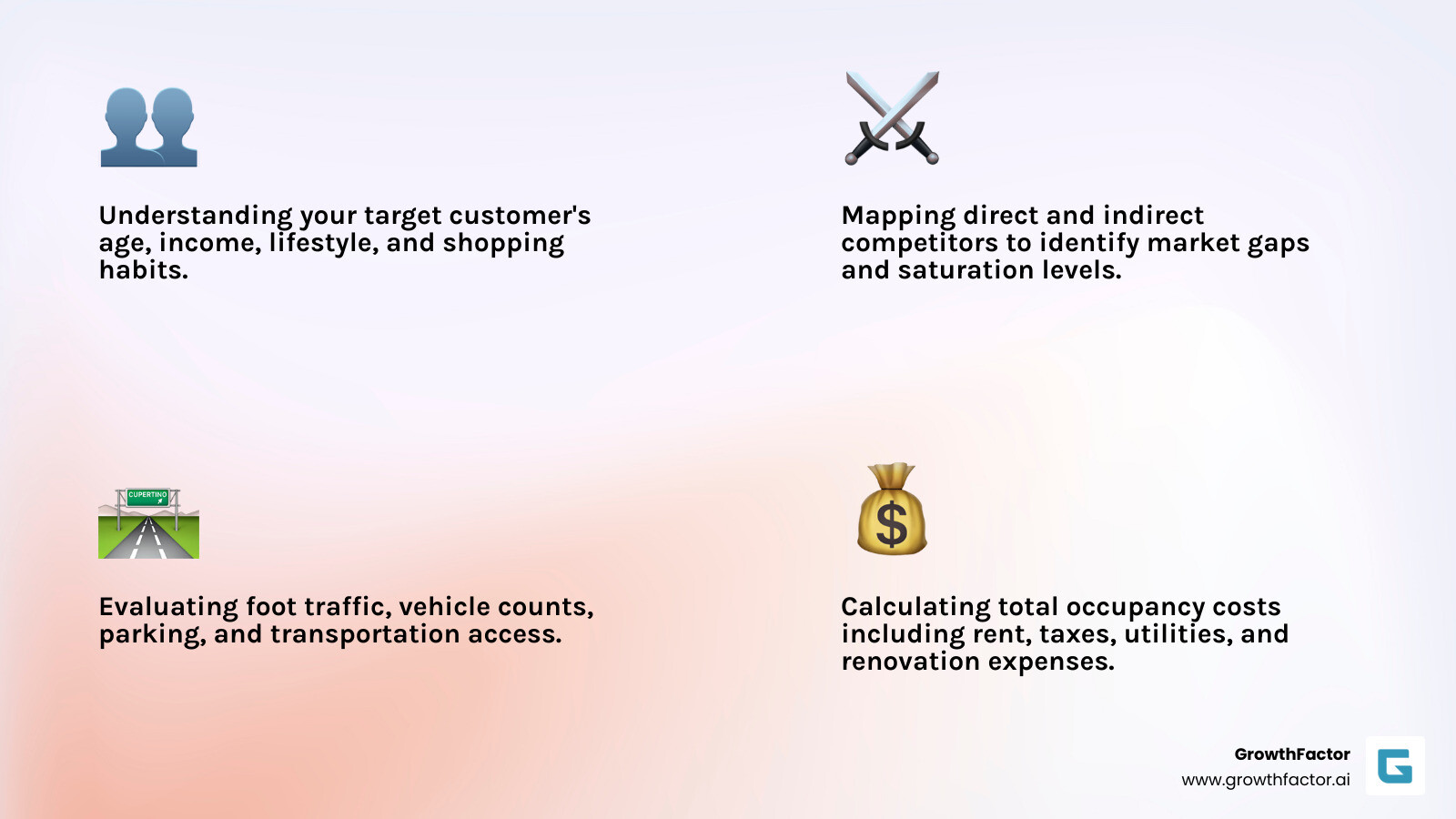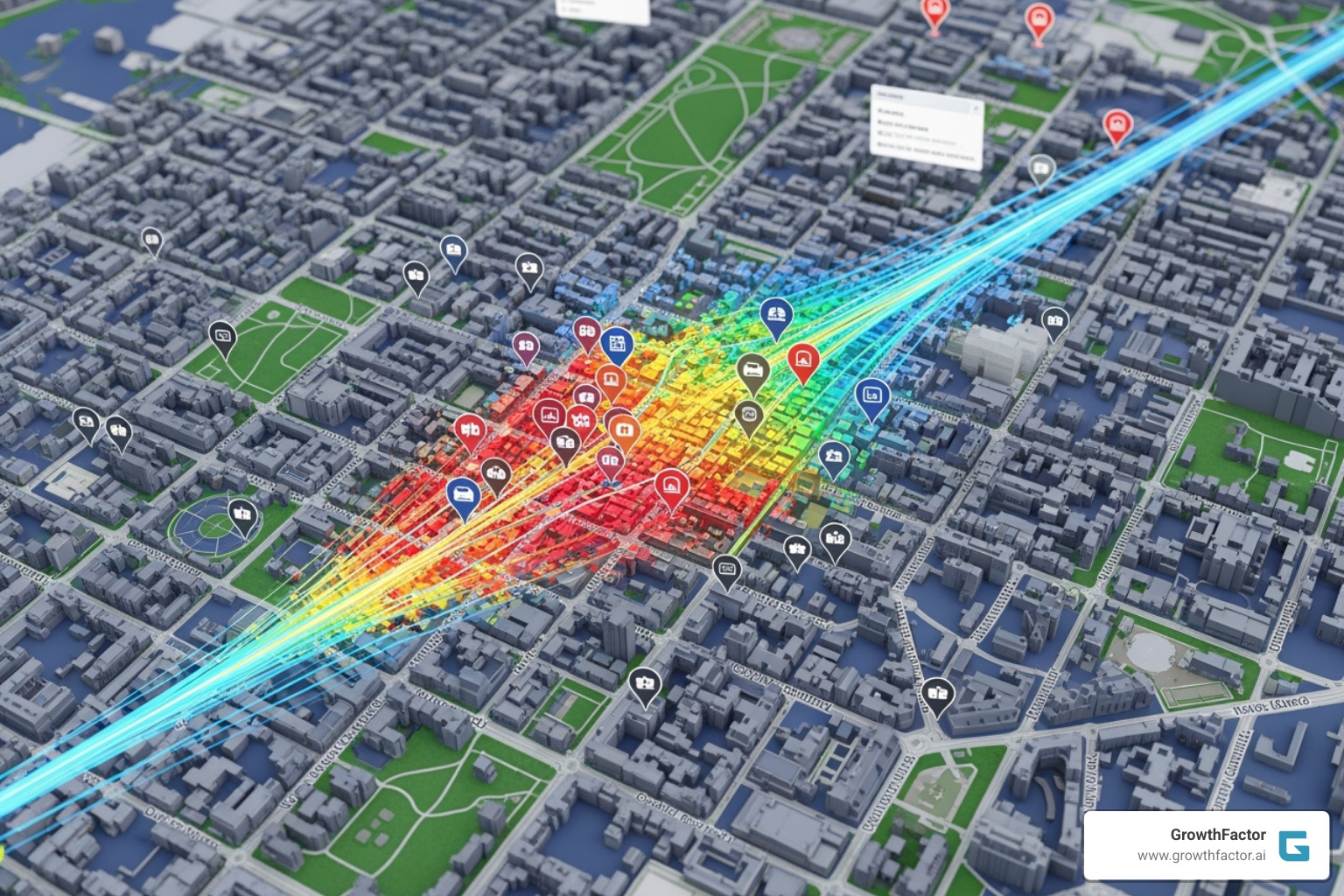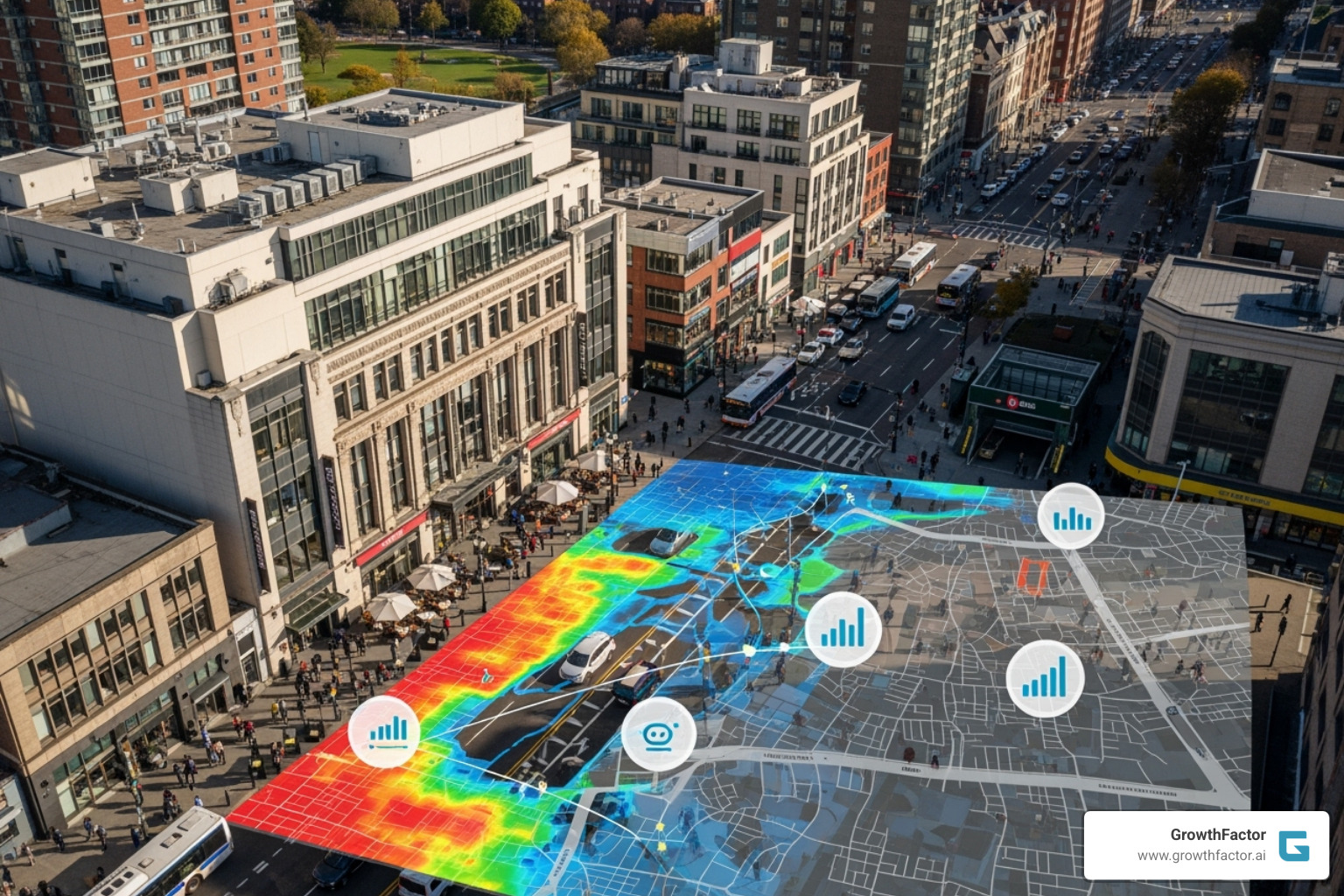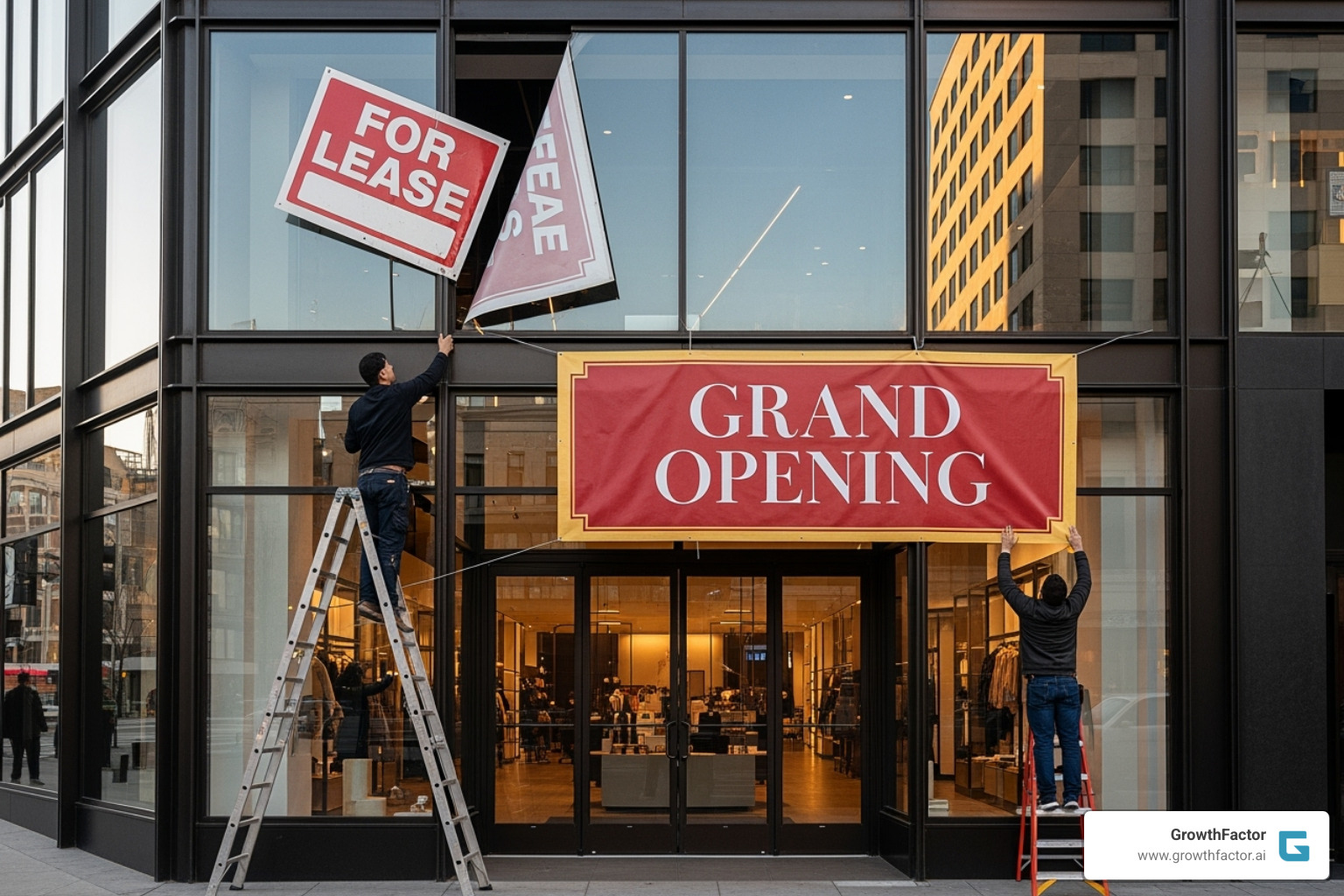Finding Your Store's Sweet Spot with Retail Location Analysis
Why Retail Location Analysis is Your Make-or-Break Decision
Retail location analysis is the systematic process of evaluating potential store sites using demographic data, competitive intelligence, traffic patterns, and financial metrics to identify locations with the highest probability of success. This data-driven approach has replaced traditional "gut feeling" decisions as retailers recognize that the right location can drive profitability while the wrong one can sink a business.
Key Components of Retail Location Analysis:
- Demographics & Psychographics - Understanding your target customer's age, income, lifestyle, and shopping habits
- Competition Analysis - Mapping direct and indirect competitors to identify market gaps and saturation levels
- Accessibility & Traffic - Evaluating foot traffic, vehicle counts, parking, and transportation access
- Cost Analysis - Calculating total occupancy costs including rent, taxes, utilities, and renovation expenses
- Future Potential - Assessing planned developments, zoning changes, and long-term area growth
Despite the explosive growth of e-commerce, brick-and-mortar stores still account for 82% of retail sales in the United States. This statistic underscores why getting your location strategy right isn't just important - it's critical for survival and growth.
The stakes couldn't be higher. A well-chosen location can catapult a retail chain to success, while poor site selection can hinder growth and profitability. As retail chains face increasing pressure to expand efficiently without ballooning headcount, the traditional manual approach of spending weeks evaluating individual sites simply doesn't scale.
Modern retailers are turning to AI-powered location analytics to transform their site selection process. The global location analytics market is expected to grow from $20.6 billion in 2023 to $38.5 billion by 2028, reflecting how crucial data-driven decision making has become for retail success.
I'm Clyde Christian Anderson, CEO of GrowthFactor.ai and a former retail real estate professional who has personally evaluated hundreds of potential store locations. My experience spans from front-line retail operations to investment banking, giving me unique insights into how retail location analysis can make or break expansion strategies.

What is Retail Location Analysis and Why is it Your Most Critical Decision?

Imagine spending months preparing for a new store opening, only to watch it struggle because you chose the wrong location. It happens more often than you'd think, and it's exactly why retail location analysis has become the make-or-break decision for modern retailers.
Retail site selection is the strategic process of evaluating potential store locations using concrete data rather than hunches. It's about understanding who your customers are, where they shop, how they move through your market, and what factors will drive them to your door. This comprehensive evaluation looks at everything from traffic patterns and demographics to competition density and long-term market trends.
Here's the reality: your location choice impacts virtually every aspect of your business. A strategically chosen site can boost your brand presence, drive consistent foot traffic, and create natural marketing advantages. Customers find you more easily, your operations run more smoothly, and your profitability gets a significant head start.
On the flip side, a poor location choice can drain resources faster than you might expect. Low visibility, difficult access, or the wrong customer base can turn even the best retail concept into a struggle. We've seen this pattern repeat throughout the industry, where location missteps compound into serious business challenges.
The stakes are particularly high because location decisions create long-term commitments. Unlike marketing campaigns or inventory choices that you can adjust quickly, a lease typically locks you in for years. This makes risk mitigation through thorough analysis absolutely essential for long-term success.
Smart retailers are moving away from the old "drive around and see what feels right" approach. Instead, they're embracing data-driven strategies that reveal the true potential of each site. For a deeper dive into this strategic approach, check out More info about the Retail Site Selection Process.
The consequences of getting this wrong can be severe. Take Forever 21's expansion strategy, which contributed to their eventual bankruptcy. Their story offers valuable insights into how location decisions can impact an entire retail empire. You can explore these Lessons in Retail Site Selection from Forever 21's Bankruptcy to understand what went wrong and how to avoid similar pitfalls.
The good news? With the right approach and tools, you can stack the odds in your favor. Modern retail location analysis combines traditional market knowledge with advanced analytics to help you make confident decisions. It's about finding that sweet spot where your target customers naturally gather, where your brand can thrive, and where your investment will pay off for years to come.
The Core Pillars of a Winning Retail Location Analysis

Think of successful retail location analysis like building a house – you need a solid foundation with multiple support pillars. Each pillar represents a critical factor that, when combined, creates the complete picture of whether a location will thrive or struggle.
The beauty of a comprehensive evaluation lies in how these factors work together. A location might score perfectly on foot traffic but fail miserably on demographics. Or it could have ideal customer demographics but terrible accessibility. The art is in balancing these key factors to create a robust site selection checklist that considers every angle.
This multi-faceted approach has evolved far beyond the old-school method of driving around and "feeling" whether a spot was right. Today's retailers need systematic processes that can be replicated across multiple markets and scaled efficiently. For deeper insights into how this systematic approach works across different property types, explore More info on Real Estate Site Selection.
Analyzing Customer Demographics and Psychographics
Understanding your customer is like having a backstage pass to their lives – you get to see what really drives their decisions. This pillar starts with target audience profiling, diving deep into age groups, income levels, education, and household composition. But here's where it gets interesting: we're not just looking at who they are, but where they're going.
The suburbanization trend is reshaping retail landscapes across America. With 72 million+ millennials buying first homes and starting families, entire demographic patterns are shifting. What used to be urban-focused retail strategies now need to account for young professionals moving to suburban areas with different shopping patterns and lifestyle needs.
Beyond basic demographics, psychographic insights reveal the "why" behind shopping behaviors. Do your customers value convenience over experience? Are they price-sensitive or willing to pay premium for quality? Understanding these lifestyle and shopping habits helps align your location choice with customer expectations. A luxury boutique in a budget-conscious neighborhood is like wearing a tuxedo to a beach party – technically possible, but missing the mark entirely.
Modern local demographics analysis goes far beyond simple population counts. We examine spending patterns, shopping frequency, brand preferences, and even commuting habits to build a complete picture of your ideal customer's daily life.
Evaluating Location, Accessibility, and Foot Traffic
"Location, location, location" isn't just real estate jargon – it's the heartbeat of retail success. But what makes a location truly shine? It starts with visibility and signage potential. Can customers easily spot your store from the street? Is there clear sight lines from multiple directions?
Accessibility forms the foundation of customer convenience. This means evaluating parking availability – not just the number of spaces, but their proximity to your entrance and ease of navigation. We also examine ingress and egress patterns to ensure customers can easily enter and exit your location without fighting traffic or confusing layouts.
Public transportation access has become increasingly important, especially as younger demographics rely less on personal vehicles. A location near bus routes, subway stations, or bike paths can significantly expand your customer base.
The real magic happens with foot traffic analysis. We don't just count bodies – we analyze pedestrian traffic patterns and vehicle traffic flows to understand customer behavior. High-speed highway traffic might show impressive daily counts, but if cars can't safely slow down or turn in, those numbers are meaningless.
Convenience factor ties everything together. The easier you make it for customers to visit, park, shop, and leave, the more likely they are to return. For a comprehensive guide on optimizing these location factors, check out More info on Retail Store Site Selection.
Scouting the Competitive Landscape and Market Saturation
The competitive landscape tells a story about market opportunity and customer demand. We start by mapping direct competitors – businesses offering similar products or services – and indirect competitors who might satisfy the same customer need through different means.
Competitor density reveals crucial insights about market dynamics. Sometimes, clustering with competitors creates a retail destination effect. Think about restaurant rows or electronics districts – customers actually prefer having multiple options in one area. Other times, too much competition creates oversaturation where everyone struggles for market share.
The key is identifying market gaps – areas where customer demand exists but competition is limited. These whitespace opportunities often represent the sweet spot for new locations. However, we also need to understand why competitors might be absent. Is it lack of demand, challenging logistics, or simply an overlooked opportunity?
Market saturation analysis helps avoid the trap of entering oversaturated markets where declining foot traffic signals too many similar businesses competing for the same customers. Understanding these dynamics helps retailers position themselves strategically rather than just following the crowd. Learn more about thriving in competitive environments through this market saturation resource.
Real-world examples provide valuable lessons. The Case study on Jack in the Box's location strategy demonstrates how location decisions impact long-term viability across different market conditions.
Assessing Co-Tenancy, Nearby Businesses, and Future Developments
Your retail neighbors can make or break your success. Co-tenancy analysis examines how surrounding businesses impact your potential performance. Anchor tenants like major department stores or grocery chains act as traffic magnets, drawing customers who might find your business while visiting these established destinations.
Complementary businesses create natural synergies that benefit everyone. A coffee shop near a bookstore, or a juice bar next to a fitness studio – these combinations tap into shared customer bases and create convenient shopping experiences. The right mix generates customer-drawing power that individual stores couldn't achieve alone.
Business synergy extends beyond immediate neighbors to the overall retail ecosystem. Shopping centers with diverse, complementary tenants typically outperform those with competing or unrelated businesses. This creates a vibrant environment where customers can accomplish multiple tasks in one trip.
Looking ahead, planned construction and zoning changes can dramatically alter a location's future potential. New residential developments, office complexes, or transportation infrastructure can transform sleepy areas into busy commercial districts. Conversely, planned road closures or zoning restrictions might limit future growth.
Future development assessment requires studying municipal planning documents, construction permits, and urban development initiatives. Consider how ambitious projects like Boston's Squares + Streets plan create new mixed-use districts that reshape entire neighborhoods. Understanding these long-term potential factors helps ensure your location choice remains viable for years to come.
Calculating Costs, Logistics, and Financial Viability
The most attractive location means nothing if the numbers don't work. Financial viability starts with obvious costs like rent and property taxes, but extends far beyond basic occupancy expenses. Renovation costs can vary dramatically based on existing infrastructure, local building codes, and your specific requirements.
Utilities and maintenance expenses differ significantly between locations. Energy costs, waste management, security needs, and ongoing maintenance requirements all impact your bottom line. These operational expenses compound over time, making initial analysis crucial for long-term profitability.
Supply chain proximity affects both costs and customer satisfaction. Locations near major transportation routes and distribution centers reduce shipping expenses and enable faster inventory replenishment. Distribution efficiency becomes even more critical as customer expectations for product availability continue rising.
Zoning regulations and local restrictions can significantly impact operations. Some areas have specific requirements for signage, operating hours, or business types. Blue laws in certain jurisdictions might restrict Sunday operations, affecting weekly revenue potential.
Lease term complexity requires careful attention to detail. Commercial leases can be as binding as marriage and as complex as a Rubik's Cube, with terms affecting everything from renewal options to modification rights. Understanding these contractual obligations helps avoid costly surprises down the road.
The goal is balancing location potential with total cost of operation to ensure sustainable profitability. Even the perfect location becomes a liability if costs exceed revenue generation capacity over the long term.
Gaining a Competitive Edge with Technology and AI

Remember when site selection was all about driving around neighborhoods with a notepad and trusting your gut? Those days are fading fast. The evolution from intuition to data science has transformed retail location analysis from educated guesswork into a precise, predictable process. This shift isn't just happening in boardrooms - it's driving incredible market growth, with the global location analytics market growing rapidly from $20.6 billion in 2023 to an expected $38.5 billion by 2028.
What's driving this explosion? Simply put, data-driven real estate decisions deliver better results with greater efficiency and accuracy. When you can predict a store's performance before signing a lease, you're not just saving money - you're building a competitive advantage that compounds over time. For a deeper dive into how data is reshaping the industry, explore More info on Site Selection Data.
Essential Metrics for Modern Retail Location Analysis
Today's retail location analysis goes far beyond counting cars in a parking lot. We now have access to sophisticated metrics that reveal the true potential of any location. Foot traffic patterns tell us not just how many people pass by, but when they visit, how long they stay (dwell time), and what draws them to the area. This intelligence helps optimize everything from staffing schedules to inventory planning.
Catchment area analysis has evolved from drawing circles on maps to understanding real-world travel patterns. A catchment area is the geographic region from which a store attracts most of its customers, shaped by factors like traffic flow, barriers, and competing destinations. Getting this right is crucial for accurate sales forecasting and avoiding the costly mistake of cannibalizing your own stores.
Trade area definition takes this a step further, identifying the specific geographic boundaries that generate the vast majority of your revenue. This isn't just academic - over-defining your trade area leads to inflated sales projections, while under-defining it leaves potential revenue on the table.
Modern analytics also enable cross-shopping analysis, revealing other stores and businesses your target customers frequent. This insight can guide strategic co-tenancy decisions and help you position your store within the broader retail ecosystem. Void analysis is particularly powerful, identifying market gaps where favorable conditions exist but competitors are absent - essentially finding hidden opportunities in plain sight.
All these metrics feed into sophisticated sales forecasting models that combine foot traffic, demographics, competitive analysis, and historical performance data. For detailed strategies on this critical aspect, check out More info on Sales Forecasting Tips for Retail Site Selection.
How AI is Revolutionizing the Site Selection Process
Here's where things get really exciting. The sheer volume of data available today would overwhelm any human analyst, but AI thrives on complexity. Predictive modeling powered by artificial intelligence can process vast amounts of geospatial, demographic, and mobility data to forecast sales performance and market demand with remarkable accuracy. It's like having a crystal ball that actually works.
AI excels at processing big data from sources like satellite imagery, anonymized mobile data, and demographic databases to uncover patterns and correlations that human analysts might miss. This capability enables identifying lookalike locations - finding new sites that share the characteristics of your most successful existing stores. Instead of starting from scratch in each new market, you can rapidly identify promising locations based on proven success patterns.
The automation aspect is a game-changer for productivity. AI can handle the time-consuming tasks of data collection, initial qualification, and preliminary evaluation, freeing your team to focus on strategic decision-making. This is precisely how How AI is Revolutionizing Retail Site Selection is changing the industry.
Enhancing decision speed might be AI's most valuable contribution. With AI-powered tools, teams can evaluate five times more sites efficiently, providing rapid insights that enable quicker, more confident expansion decisions. At GrowthFactor, our AI Agent Waldo is designed specifically for this purpose, automating qualification and evaluation processes to keep you ahead of the competition. To understand the full potential of AI in this space, explore More info on AI Location Intelligence.
The result? Retail location analysis that's faster, more accurate, and more comprehensive than ever before. You're not just keeping up with the competition - you're leaping ahead of it.
Frequently Asked Questions about Retail Location Analysis
What are the first steps in retail location analysis?
The first steps involve defining your brand's target customer profile, understanding the characteristics of your current top-performing stores, and establishing clear goals for expansion. This foundational work ensures your analysis is focused on finding locations with the highest probability of success, rather than just any available space.
We always begin by asking three crucial questions: Who are we trying to attract? What makes our existing successful stores thrive? What does success look like for this new location? This helps us paint a clearer picture of general areas to target and ensures our subsequent data analysis is precisely focused.
Think of it like planning a dinner party - you wouldn't start shopping for ingredients without knowing who's coming and what they like to eat! The same principle applies to retail location analysis. By understanding your ideal customer's demographics, shopping habits, and preferences, we can identify areas where they live, work, and spend their time.
How do you assess the performance of a potential shopping center?
Assessing a shopping center goes far beyond a quick walk-through and counting empty storefronts. We dive deep by analyzing several key factors that determine whether a center will be a goldmine or a money pit for your business.
First, we examine the anchor tenants - these are the big-name stores that draw customers to the center in the first place. A strong grocery store or department store can be like a magnet, pulling in steady foot traffic that benefits all the smaller retailers around it.
Using advanced location analytics, we can determine the center's true trade area - where its customers actually come from, not just a theoretical radius on a map. We also analyze customer dwell time (how long visitors stay) and cross-shopping patterns (which other stores they visit within the center).
This data helps us determine if the center's audience aligns with your brand's target customers, ensuring a synergistic environment. For example, a plaza with a grocery store, pharmacy, and coffee shop encourages people to run multiple errands in one trip, creating a built-in customer base that naturally flows between businesses.
How does a physical store location impact online sales?
This is one of the most fascinating and often underestimated connections in modern retail! A physical store acts as a powerful marketing tool and fulfillment hub, significantly boosting online sales in its surrounding area - a phenomenon sometimes called the "halo effect."
Your brick-and-mortar location provides crucial brand visibility in the community, serves as a convenient spot for returns and pickups, and builds trust with customers who prefer to see a physical presence before making online purchases. It's like having a 24/7 advertisement for your brand right in the neighborhood.
The flip side is equally important to understand. Closing a physical store can lead to a sharp decline in local online revenue. Reports from sources like Competitor Monitor indicate that closing a physical store could reduce online sales by as much as 50% in that market.
This dramatic impact happens because the store closure reduces brand visibility and eliminates the convenience factor for returns and pickups. It proves that brick-and-mortar and e-commerce aren't competing against each other - they're actually complementary channels working together in a robust omnichannel strategy.
Conclusion

Throughout this guide, we've journeyed through the essential landscape of retail location analysis, exploring how the right approach can transform your expansion strategy from guesswork into a precision science. We've covered the four core pillars that form the foundation of successful site selection: understanding your customer demographics and psychographics, evaluating location accessibility and foot traffic patterns, scouting the competitive landscape for opportunities, and calculating the true costs and logistics of each potential site.
The retail world has fundamentally changed. The days of making location decisions based on gut feelings or driving around looking for "For Lease" signs are behind us. Today's successful retailers accept a data-driven strategy that leverages advanced analytics and AI to uncover insights that would be impossible to find through traditional methods alone.
This shift toward technology isn't just about staying current—it's about future-proofing your retail footprint. With 82% of retail sales still happening in physical stores, getting your location strategy right remains absolutely critical. The retailers who thrive in the coming years will be those who can efficiently evaluate more sites, make faster decisions, and expand with confidence.
At GrowthFactor, we're passionate about empowering site selection teams with the tools they need to succeed. Our AI-powered solutions help you move beyond the limitations of spreadsheets and manual analysis. With Waldo, our AI Agent, your team can evaluate five times more sites efficiently while automating the time-consuming qualification and evaluation processes that traditionally bog down expansion efforts.
We understand that every retail business is unique, which is why we offer flexible solutions to match your needs. Our Core plan at $500 provides essential functionality for smaller operations, while our Growth plan at $1,500 offers expanded capabilities for growing chains. For larger enterprises with complex requirements, our Enterprise plans deliver customized solutions.
The difference between a thriving retail location and an empty storefront often comes down to the quality of analysis that went into the selection process. When you're ready to make confident expansion decisions backed by robust data and AI-powered insights, we're here to help.
Ready to revolutionize how your team approaches retail expansion? Find how Waldo, the AI Agent, can revolutionize your retail site selection and report building and find how the right technology can turn your next "For Lease" opportunity into a "Grand Opening" success story.
Citations
The human algorithm
Request Your demo
Schedule meeting
Or submit your information below and we'll be in touch to schedule.



